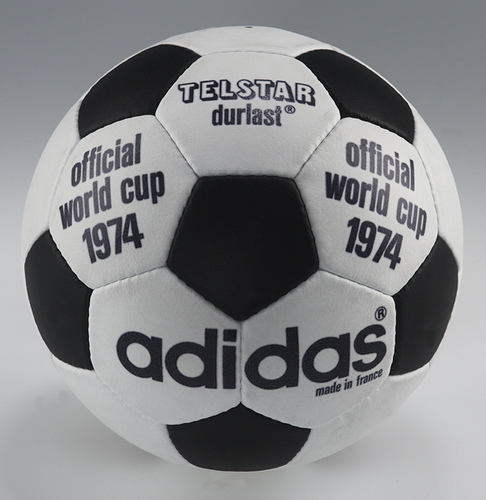- A post on the BBC site, where the problem is explained roughly, up to the fact that the UK authorities refused to propose a correct design for the post after Matt Parker raised up the issue
- A video by Matt Parker on his YouTube channel, @standupmaths, where he discusses how soccer balls are made, especially in the 2014 WWC or the UK Premier Ligue
- A text by Étienne Ghys on the large audience website Image des mathématiques about the 2014 WWC soccer ball (in French)
- Euler's formula has a rich history which is evoked in the Wikipedia page quoted above, but is also the matter of the great book Proofs and Refutations by Imre Lakatos.
Friday, August 4, 2023
On soccer balls
This is a swift adaptation of a thread on Mastodon written after having read the beginning of Mara Goyet's column in yesterday's edition of Le Monde (please don't spoil the game by jumping to it now).
So look at this picture below.
Does something strike you in it? The directions? The ball? The character? Nothing?
68 people voted, roughly one third found nothing, and two thirds saw that there's a problem with the ball. One nice remark from Sarah was that the ball was larger than the character!
So, what's the problem with the ball? As it has been observed by Matt Parker in 2017, no soccer ball can be made following what the picture suggests: what we see is a combination of hexagons, some black, some white, and it is actually impossible to stitch hexagons together to do a ball. Or the other way round, it is impossible to take a ball and draw an hexagonal pattern on it.
On the other hand, it is quite easy to draw an hexagonal pattern on a plane, and many kitchen/bathrooms feature such a tiling. Here is a photograph (stolen to somebody on Pinterest) of a 4th cent. BCE pavement (Porta Rosa, in the city of Elea-Velia, Italy)
But on a ball, nope.
So how is a soccer ball made if not with hexagons? — The point is that is not made of hexagons only : it has 20 hexagons (so that the sign post above is slightly reminiscent of a soccer ball) but it also has 12 pentagons.
The whole structure forms what is called a truncated icosahedron.
A regular icosahedron, as shown on the picture below (the Spinoza monument in Amsterdam) would have 20 triangular faces, such that five of them meet at each vertex. If one make a cut at these vertices, each of them is replaced by a pentagon, and one get the truncated icosahedron.
I should add the mathematical explanation for the impossibility of stitching hexagons into a ball.
This comes from a formula due to Euler that if one stitches polygons to a ball in anyway, some relation must hold : the number of vertices minus the number of edges plus the number of polygons is always equal to 2.
Imagine you have some number of hexagons, say \(n\). That makes \(6n\) edges, but each time you make a stitch, you glue two edges together, hence \(3n\) edges in the end. What about the vertices, namely the points when at least 3 hexagons will be joined? If the picture is correct, then 3 hexagons meet at each vertex, so the number of vertices is \(6n/3=2n\) — Then Euler's formula says \(2n - 3n + n = 2\), which is absurd.
… Now, is this really a necessity that exactly 3 hexagons meet at each vertex? Couldn't we have more complicated configurations?
As a matter of fact, I'm not sure about the answer, and I can try imagine a strange configurations where there are a bunch of hexagons meeting in a different number of points.
But algebra seems to contradict this in the end. Let me try.
Assume we have \(s_3\) vertices where 3 hexagons meet, \(s_4\) vertices where 4 vertices meet, etc. The total number of vertices is then \(s = s_3 + s_4 + \cdots\).
The \(n\) hexagons contribute to \(6n\) vertices, but those of type \(s_3\) count for 3 of them, those of type \(s_4\) for 4 of them, etc. so that \(6n = 3s_3 + 4s_4 +\cdots = 3s + d\), where \(d\) is defined by \(d = s_4 + 2s_5+ \cdots\). In particular, we have \(6n \geq 3s\), which means \(2n \geq s\).
Euler's formula still says \(2 = s - 3n + n = s - 2n \leq 0\), still giving a contradiction.
And if you followed that proof, you may object that there is actually a way to stitch hexagons into a ball: it consists in stitching exactly 2 hexagons together. You get something completely flat, but if you blow enough air or fill it with wool, so that it gets round enough, you might feel that you got a ball. The picture made by the hexagons on a ball is that of an hexagon drawn on the equator, each of them covering one hemisphere.
Here are additional references
Subscribe to:
Post Comments
(
Atom
)




No comments :
Post a Comment